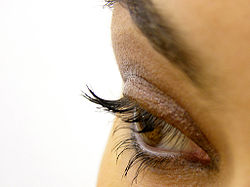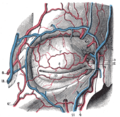- Eyelid
-
Eyelid 
Upper and lower eyelids Latin palpebra inferior, palpebra superior Gray's subject #227 1025 Artery lacrimal, superior palpebral, inferior palpebral Nerve upper: infratrochlear, supratrochlear, supraorbital, lacrimal
lower: infratrochlear, branches of infraorbitalMeSH Eyelids An eyelid is a thin fold of skin that covers and protects an eye. With the exception of the prepuce and the labia minora, it has the thinnest skin of the whole body. The levator palpebrae superioris muscle retracts the eyelid to "open" the eye. This can be either voluntarily or involuntarily. The human eyelid features a row of eyelashes which serve to heighten the protection of the eye from dust and foreign debris, as well as from perspiration. "Palpebral" (and "blepharo") means relating to the eyelids. Its key function is to regularly spread the tears and other secretions on the eye surface to keep it moist, since the cornea must be continuously moist. They keep the eyes from drying out when asleep. Moreover, the blink reflex protects the eye from foreign bodies.
Contents
Anatomy
Layers
The eyelid is made up of several layers; from superficial to deep, these are: skin, subcutaneous tissue, orbicularis oculi, orbital septum & tarsal plates, and palpebral conjunctiva. The meibomian glands lie within the eyelid and secrete the lipid part of the tearfilm.
Skin
The skin is similar to areas elsewhere, but has more pigment cells. In diseased persons these may wander and cause a discoloration of the lids. It contains sweat glands and hairs, the latter becoming eyelashes as the border of the eyelid is met.[1]
Innervation
In humans, the sensory nerve supply to the upper eyelids is from the infratrochlear, supratrochlear, supraorbital and the lacrimal nerves from the ophthalmic branch (V1) of the trigeminal nerve (CN V). The skin of the lower eyelid is supplied by branches of the infratrochlear at the medial angle, the rest is supplied by branches of the infraorbital nerve of the maxillary branch (V2) of the trigeminal nerve.
As with most of the muscles of the orbit, it is innervated by the superior division of the oculomotor nerve (Cranial Nerve III). This is why when one looks upward, the eyelid tends to move up with it. [1] An adjoining smooth muscle, the superior tarsal muscle, is sympathetically innervated and is occasionally considered to be part of the levator palpebrae superioris.
Blood supply
In humans, the eyelids are supplied with blood by two arches on each upper and lower lid. The arches are formed by anastamoses of the lateral palpebral arteries and medial palpebral arteries, branching off from the lacrimal artery and ophthalmic artery, respectively.
Death
After death, it is common in many cultures to pull the eyelids of the deceased down to close the eyes. This is a typical part of the last offices.
Eyelid disorders
Any condition that affects the eyelid is called eyelid disorder. The most common eyelid disorders, their causes, symptoms and treatments are the following:
- Hordeolum (stye) is an infection of the sebaceous glands of Zeiss usually caused by Staphylococcus aureus bacteria. It is characterized by an acute onset of symptoms and it looks like a red bump placed underneath the eyelid. The main symptoms of styes include pain, redness of the eyelid and sometimes swollen eyelids. Styes usually disappear within a week without treatment. Otherwise, antibiotics may be prescribed and home remedies such as warm water compresses may be used to promote faster healing. Styes are normally harmless and do not cause long lasting damage.
- Chalazion is caused by the obstruction of the oil glands and can occur in both upper and lower eyelids. Chalazia may be mistaken as styes due to the similar symptoms. This condition is however less painful and it tends to be chronic. Chalazia heals within few months if treatment is administered and otherwise it can resorb within two years. Chalazia that do not respond to topical medication is usually treated with surgery as a last resort.
- Blepharitis is a common condition that causes inflammation of the eyelids and which is quite difficult to manage because it tends to recur.[2] This condition is mainly caused by staphylococcus infection and scalp dandruff. Blepharitis symptoms include burning sensation, the feeling that there is something in the eye, excessive tearing, blurred vision, redness of the eye, light sensitivity, red and swollen eyelids, dry eye and sometimes crusting of the eyelashes on awakening. Treatment normally consists in maintaining a good hygiene of the eye and holding warm compresses on the affected eyelid to remove the crusts. Gently scrubbing the eyelid with the warm compress is recommended as it eases the healing process. In more serious cases, antibiotics may be prescribed.
- Entropion usually results from aging, but sometimes can be due to a congenital defect, a spastic eyelid muscle, or a scar on the inside of the lid that could be from surgery, injury, or disease.[3] It is an asymptomatic condition that can rarely lead to trichiasis which requires surgery. It mostly affects the lower lid and it is characterized by the turning inward of the lid, toward globe.
- Ectropion is another aging-related eyelid condition that causes chronic eye irritation and scarring. It may also be the result of allergies and its main symptoms are excessive tearing and hardening of the eyelid conjunctiva.
- Eyelid edema is a condition in which the eyelids are swollen and contain excessive fluid. It may be serious when it increases the intraocular pressure. Eyelid edema is caused by an allergic reaction that one has to food, drugs, plan allergens, trichinosis or infections.[4] The main symptoms are swollen red eyelids, pain, and itching. Treatment may vary depending on what is causing the condition. Whereas infections are fought against with antibiotics, allergic edemas treatments consists in staying away from the allergen. Chronic bouts of eyelid edema can lead to blepharochalasis.
- Eyelid tumors may also occur. Basal cell carcinomas are the most frequently encountered kind of cancer affecting the eyelid, making up 85% to 95% of all malignant eyelid tumors.[5] The tumors may be benign or malignant. Usually benign tumors are localized and removed before becoming a cancerous threat and before they become large enough to impair one's vision. Malignant tumors on the other hand tend to spread to surrounding areas and tissues.
- Blepharospasm (eyelid twitching) is an involuntary spasm of the eyelid muscle. The most common factors that make the muscle in the eyelid twitch are fatigue, stress, and caffeine.[6] Eyelid twitching is not considered a harmful condition and therefore there is no treatment available. Patients are however advised to get more sleep and drink less caffeine.
- Eyelid dermatitis is the inflammation of the eyelid skin. It is mostly a result of allergies or it is triggered by contact dermatitis of the eyelid. Symptoms that one may experience are dry and flaky skin on the eyelids and swollen eyelids. The affected eyelid may itch. Treatment consists in proper eye hygiene and avoiding the allergens that trigger the condition. In rare cases, topical creams may be used but only under a doctor's supervision.
- Ptosis (drooping eyelid) is when the upper eyelid droops or sags due to weakness or paralysis of the levator muscle (responsible for raising the eyelid), or due to damage to nerves controlling the muscle. It can be a manifestation of the normal aging process, a congenital condition or due to an injury or disease. Risk factors related to ptosis include diabetes, stroke, Horner syndrome, myasthenia gravis, brain tumor or other cancers that can affect nerve or muscle function.
- Ablepharia (Ablepharon) Congenital absence of or reduction in the size of the eyelids.[7]
Eyelid surgeries
The eyelid surgeries are called blepharoplasties and are performed either out of medical reasons or to improve one's facial appearance.
Most of the cosmetic eyelid surgeries are aimed to enhance the look of the face and to boost one's self-confidence by restoring a youthful eyelid appearance. They are intended to remove fat and excess skin that may be found on the eyelids after a certain age. Cosmetic eyelid surgeries are mostly used to regain a younger and refreshed look but the costs are quite raised, so not everyone affords them.
Eyelid surgeries are also performed to improve one's peripheral vision or to treat different eyelid related conditions such as chalazion, eyelid tumors, ptosis, trichiasis, and other.
Eyelid surgeries are overall safe procedures but they carry certain risks since the area on which the operation is performed is so close to the eye.
See also
- Blepharospasm
- Cellulitis
- Chalazion
- Dermatochalasis
- Ectropion
- Entropion
- Hay-Wells syndrome
- Ptosis
- Stye (Hordeolum)
Surgeries
Image gallery
References
- ^ "eye, human." Encyclopædia Britannica. Encyclopaedia Britannica Ultimate Reference Suite. Chicago: Encyclopædia Britannica, 2010.
- ^ "Facts About Blepharitis". http://www.nei.nih.gov/health/blepharitis/blepharitis.asp. Retrieved 2010-03-30.
- ^ "Eyelid Disorders". http://www.healthline.com/galecontent/eyelid-disorders. Retrieved 2010-03-30.
- ^ "Upper Eyelid Edema Treatment and Symptoms". http://www.uppereyelid.net/edema.html. Retrieved 2010-03-30.
- ^ "Eyelid and Orbital Tumors". http://www.eyecareamerica.org/eyecare/conditions/eye-tumors/index.cfm. Retrieved 2010-03-30.[dead link]
- ^ "Eyelid twitch". http://www.nlm.nih.gov/medlineplus/ency/article/000756.htm. Retrieved 2010-03-30.
- ^ Taber's Cyclopedic Medical Dictionary, Edition 21, Page-6.
Sources
- "eye, human."Encyclopædia Britannica from Encyclopædia Britannica 2006 Ultimate Reference Suite DVD 2009.
Head and neck anatomy – accessory visual structures (TA 15.2.7, TH H3.11.08.6, GA 10.1021) Eyelid Tarsus (Meibomian pelicle) • Medial palpebral ligament • Epicanthic fold • Meibomian gland • Ciliary glands • Eyelash
Gland of ZeisLacrimal apparatus Lacrimal lake • Lacrimal gland • Lacrimal canaliculi • Lacrimal punctum • Lacrimal papilla • Nasolacrimal duct • Lacrimal sac • Lacrimal caruncle • Krause's glandsOther Periorbita • Orbital septum • Tenon's capsule • Suspensory ligament of eyeball
Conjunctiva (Plica semilunaris)
Extraocular muscles (Trochlea of superior oblique)M: EYE
anat(g/a/p)/phys/devp/prot
noco/cong/tumr, epon
proc, drug(S1A/1E/1F/1L)
Categories:- Eye anatomy
- Human anatomy
Wikimedia Foundation. 2010.








